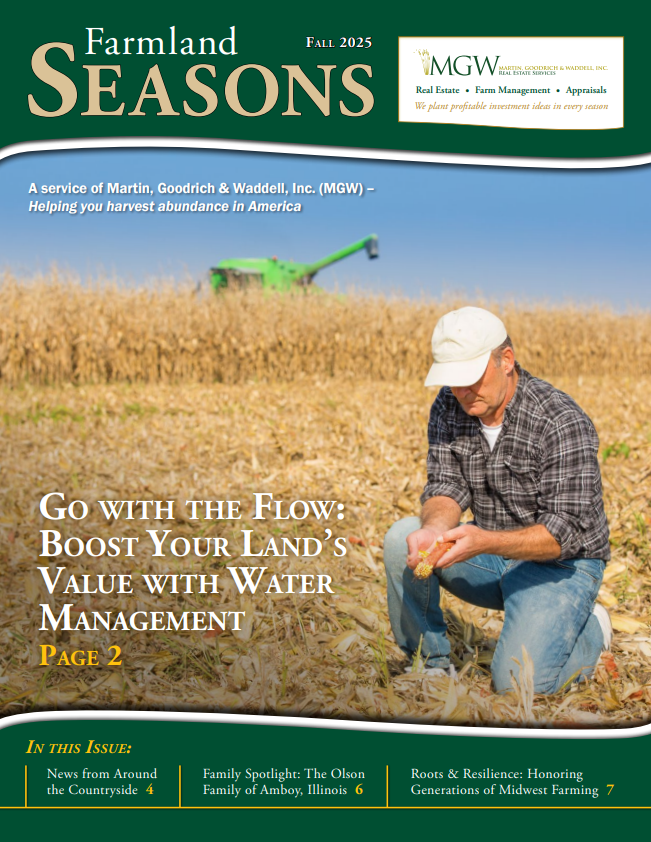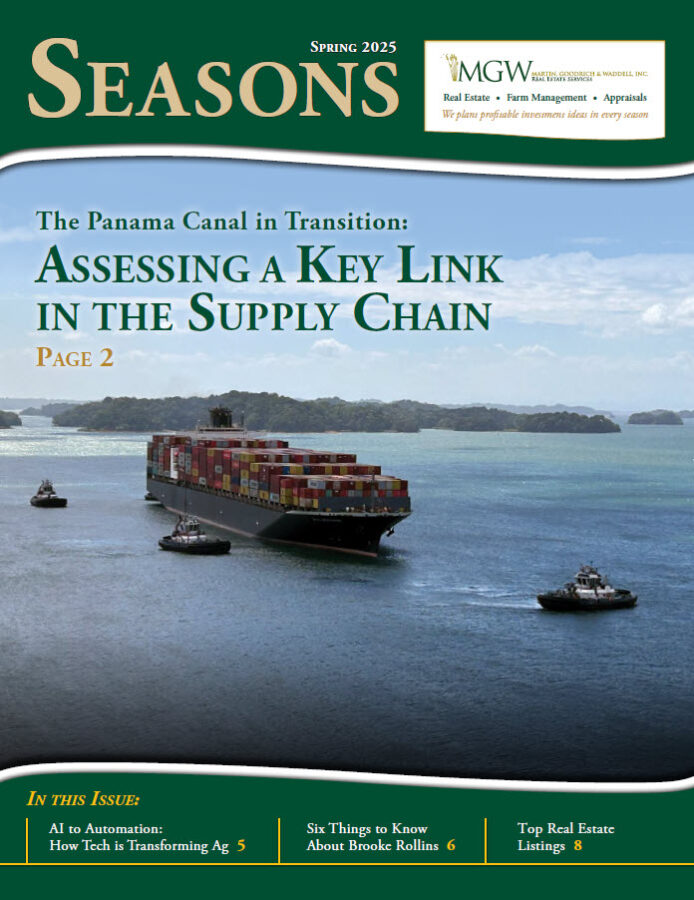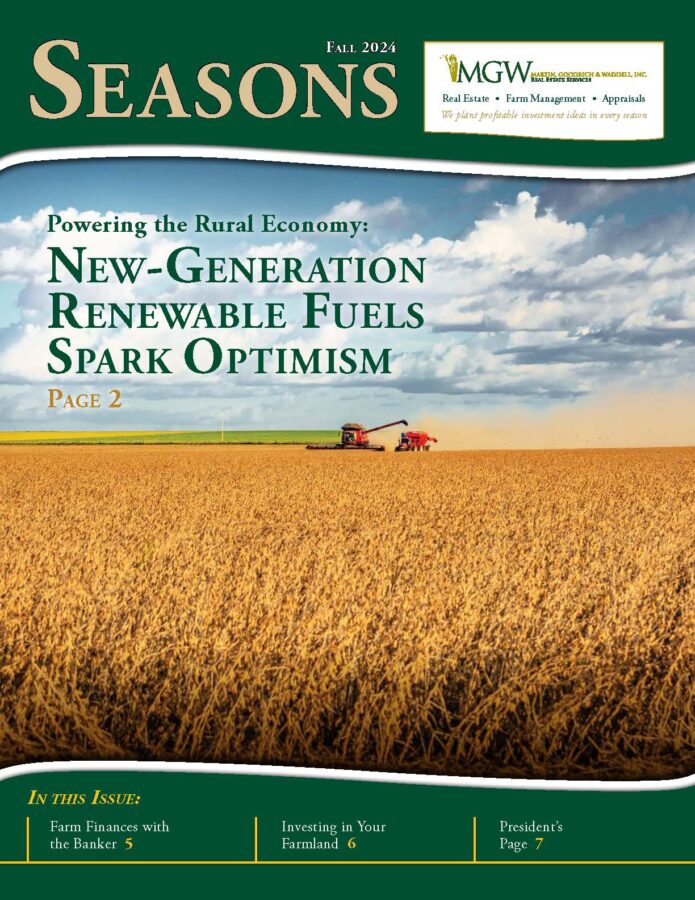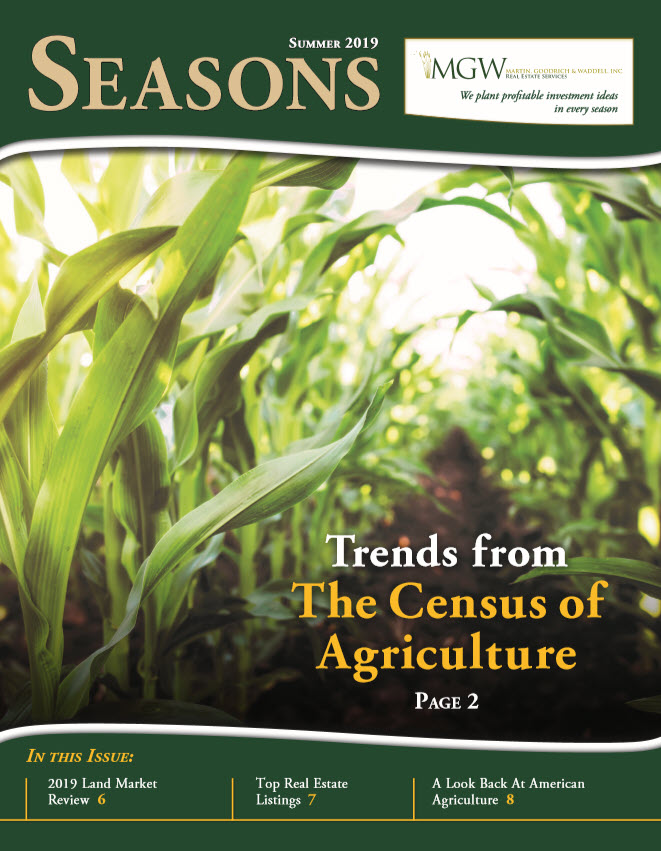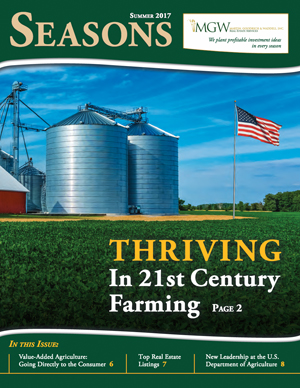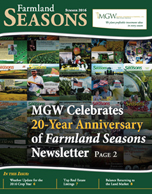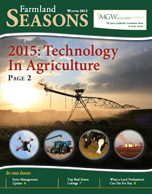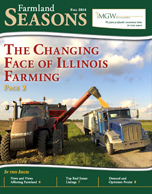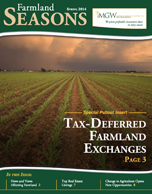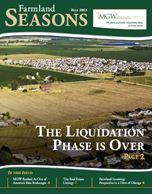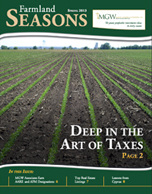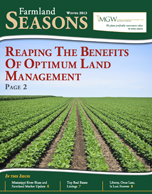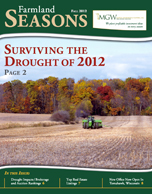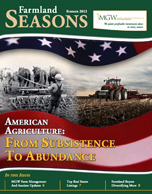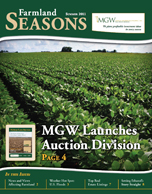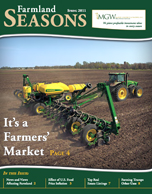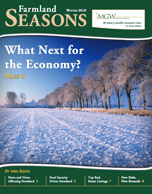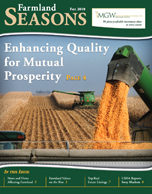Seasons Newsletter
Seasons Newsletter
Go with the Flow: Boost Your Land’s Value with Water Management – If you’ve ever observed how a wet year affects your farmland, it can reveal a
lot—including areas of your fields that have inadequate drainage. Those show up as ponds or wet spots, even after the rest of the
field dries out.
Ever considered what percentage of your acres don’t produce a crop, or only produce a partial crop, due to poor drainage? These wet areas affect your annual income and the value of your farmland.
Seasons Newsletter
A Salute to Veterans – MGW Salutes Veterans: “We don’t know them all, but we owe them all” isn’t just a quote to us. It’s something we take to heart. We’re honored to share the powerful stories of two farmer-veterans in our area. To all of America’s men and women in uniform, past, present and future, thank you and God bless you.
Specialty Crops to Agri-Tourism:
Meet the Farmers Connecting with Consumers Value-added agriculture can transform farming operations in so many positive ways. In our area, we love seeing how these unique businesses diversify farm income, boost rural economies, provide a valuable educational experience for visitors and preserve rural America’s cultural heritage.
Seasons Newsletter
The Panama Canal in Transition: Assessing a Key Link in the Supply Chain – When you think about Midwestern ag, it’s easy to focus on corn and soybean fields rather than export markets. You’re probably aware that President Trump has been shining the spotlight on a critical
link in the global ag infrastructure chain – the Panama Canal.
It’s no secret the Panama Canal is vital to American agriculture. Millions of tons of grain pass through the Panama Canal each year. In fact, 70% of all freight passing through the Panama Canal is going to or from
America. (Fun fact—did you know Panama
uses the U.S. dollar as their currency?)
Seasons Newsletter
New-Generation Renewable Fuels Spark Optimism – Growing demand for next-generation
renewable fuels could power new
opportunities for farmers, landowners,and the ag economy. You may have hear how renewable diesel (RD) and sustainable aviation fuel (SAF) might offer some exciting opportunities. The growing demand for these fuels has the potential to drive up the consumption of corn and soybeans, two key ingredients in their production.
Seasons Newsletter
Trends from The Census of Agriculture –The value of crop sales exceeded livestock sales in 2012 for only the second time in history. However, as grain prices decreased following their 2012 peak, 2017 saw a return to longer-term trends. 2017 crop sales were down 9% from 2012.
While much of Illinois is blessed with adequate natural rainfall, many operations have invested in irrigation as a way to increase
profits through consistently higher yields. The dollars spent on irrigation equipment and wells were easily justified during years of high grain prices.
Seasons Newsletter
Embracing Generations of Family Farmers – Family farms are a unique institution, continuing through time in a world where considerations of hard work, long-term thinking and commitment are often sparse. Families in agriculture have long provided a steady backbone to rural America, serving as stewards of our natural resources and taking care of the neighbors and communities in which they live. Because of their dedication to preserving farm operations, farm families are very emotionally close to their way of life and to the land on which they live. Many see themselves as temporary stewards of their farmland, managing it for future generations, just as their great-great-grandfather might have done for them.
Seasons Newsletter
Thriving In 21st Century Farming – The story of American agriculture is one of adaptability and endurance. Stories of these traits in agriculture are longstanding, and in fact they permeate the lives of American farmers. Similar to how crops withstand seasons of change and difficulty, often in the face of uphill circumstances, the strength of farmers shines brightly when needed most…
Seasons Newsletter
MGW Celebrates 20-Year Anniversary of Farmland Seasons Newsletter As we spring into a new crop year, there are strong signals that, at least for now, we’ve entered into a healthier, more balanced land market. I’ve mentioned several times over the last couple years that market changes are coming, and we should embrace them, as the long-term strength and sustainability of the ag land market depend on it…
Seasons Newsletter
Special Feature – Patriotic Stories from the Farm – It’s mid-summer. A time when we remember those throughout history who served so bravely to keep us free. In fact, 2015 marks 70 years since the end of World War II, a war that required great commitment from our entire nation. To prevail, everyone had a vital role to play. Farmers grew the food to fuel our troops, women joined men in building our war machine, and society as a whole worked together to give the best possible support for those fighting. In honor of this anniversary, we share the following stories with you—stories about two men who grew up on the farm, went to the war, and made agriculture their career.
Seasons Newsletter
2015: Technology in Agriculture – As we’ve mentioned in previous issues of Seasons, this world of ours continues being in a state of transition. As we enter 2015, global changes have created a new reality of $2 per gallon gasoline, continued high food prices, and finally the real possibility of rise in interest rates. Im being asked now more than ever, “How do all of these changes affect me and my farmland investment?”.
Seasons Newsletter
The Changing Face of Illinois Farming – As we outlined in our last edition of Seasons, this year’s binbuster crop will have many impacts on the U.S. land market. Throughout the Corn Belt, sluggish corn and soybean prices are creating opportunities far and wide for livestock farmers and ethanol producers, and it may usher in a new era of buying opportunities for growers and investors.
Seasons Newsletter
Tax-Deferred Farmland Exchanges – Expectations were high on auction day, and a spirited crowd of 250 attendees did not disappoint. The final drop of the gavel sold 1,431 acres of highly productive cropland in Macomb, Illinois to close out the 2013 auction season. The $16,800,000 sale was purchased by 12 different buyers who were among the 58 registered bidders competing at the auction.
Seasons Newsletter
The Liquidation Phase Is Over – As a result of the subprime mortgage crisis, a significant part of our focus in recent years has been on assisting banks, developers and private investors in the difficult task of selling distressed transitional properties. Properties termed “transitional” are those that can typically be developed by an “end user” sometime in the next 5 to 15 years.
Seasons Newsletter
Deep in the Art of Taxes – As lilies, daffodils and tulips poke up out of the bare ground and rain replaces snow as a welcome form of precipitation, we look forward to a new planting season. Unfortunately, March and April also mean tax season. As you wrap up your taxes for 2012, it’s also time to look ahead and see what tax planning you should begin now to help ease your future tax burden.
Seasons Newsletter
Reaping the Benefits of Optimum Land Management – We’re always looking for ways to make your land investments more valuable and earn higher returns. Fortunately, farmland values have remained strong and have historically shown good returns. But there are other ways to improve on your farmland investment. Over the years, we’ve found one of the most cost-effective ways to earn a higher return from your farmland is to invest in land improvements.
Seasons Newsletter
Surviving The Drought of 2012 – The 2012 growing season started with great promise. After several wet springs, farmers were encouraged by the beautiful, warm spring with normal precipitation. Spring floods and delayed planting were a distant memory. This year, corn and soybeans were planted in a timely fashion. It was setting up to be a good production year to meet a growing world demand. Then, the rain spigot shut off…
Seasons Newsletter
American Agriculture: From Subsistence To Abundance – It is widely held among scholars that agricultural practices in the Western Hemisphere date back to roughly 5,000 B.C. As Central and South Americans migrated northward, their primitive techniques were blended with native methods of food production. Decades and centuries passed, and, with time, early farming practices gradually grew more refined. The next several millennia saw…
Seasons Newsletter
Agriculture’s Bright Future – Become A Farmer! Seriously, it’s the best job in the 21st century. So read the headline of an article in the July 11 issue of Time. Best-selling author and commodities bull Jim Rogers recently reiterated that agriculture is in a “supercycle” that will last at least 20 more years, and that agriculture is fundamentally positioned similar to gold and silver more than.…
Seasons Newsletter
MGW Launches Auction Division – Farmland values have risen steadily since 1987 but have shot up in recent years, doubling in the past 10 years in many Corn Belt states. They rose even faster in the last half of 2010. “Propelled by rising commodity prices, farmland values in the Chicago Federal Reserve district jumped 10% in the third quarter of 2010 versus a year earlier,” reports David Oppedahl, business economist at the Chicago Fed…
Seasons Newsletter
It’s a Farmers’ Market – Farmland values have risen steadily since 1987 but have shot up in recent years, doubling in the past 10 years in many Corn Belt states. They rose even faster in the last half of 2010. “Propelled by rising commodity prices, farmland values in the Chicago Federal Reserve district jumped 10% in the third quarter of 2010 versus a year earlier,” reports David Oppedahl, business economist at the Chicago Fed…
Seasons Newsletter
What Next for the Economy? – When the U.S. Federal Reserve announced in November that it will buy $600 billion of U.S. Treasuries through June on top of an earlier round of similar purchases, it set off a volley of op-ed articles and stirred up markets. The goals of the record stimulus move are to reduce unemployment and economic stagnation. The economic malaise that started with the subprime mortgage implosion in the summer of 2007 is more virulent than past episodes…
Seasons Newsletter
A Bright Future For Farmland – Strong demand lies ahead for agricultural products, given the multiplier effect of population growth and economic growth. Add increased use of bio fuels and it’s little wonder that some estimate we’ll need another 123 to 198 million acres of cropland to feed, fuel and clothe the world by 2050—in addition to improved productivity…
Seasons Newsletter
Do Biotech Crops Make Crop Disasters Obsolete? – By 2050, the Earth will be home to 9.2 billion people versus the current 6.8 billion. At current production levels, we’d need an additional 250 million acres of cropland to feed the population—about equal to all the cropped acres in the United States. At the same time, per-capita arable land is shrinking and the growing population will increasingly claim water currently used by agriculture…
Seasons Newsletter
Enhancing Quality for Mutual Prosperity – American agriculture is expected to go through something of an extreme makeover in the next decade. Forty-two percent of farmers responding to an Iowa State University poll expect to retire in the next five years. Of those farms, only 56% have identified their successor. Of course, some farms will stay in the family. On many, however, it will mean a more open buying opportunity for neighbors or investors…

